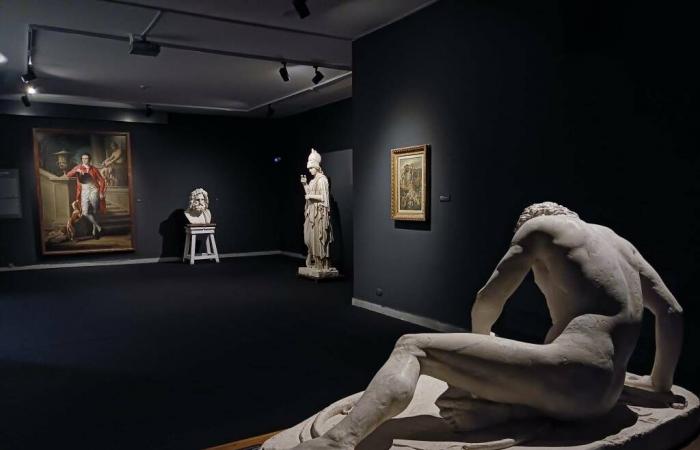The Grand Tour. A privilege of a few, becomes the heritage of all through the exhibition “The art of travelling. Italy and the Grand Tour” of the Lia Museum, presented this morning as a preview to the press, which will be held until 27 October 2024. The title is eloquent and announces a journey, the layout of which is in step with modernity without the magic of the past vanishes, which immerses the spectator in a not so distant era. The comparison is not bold if you think about what the eighteenth, nineteenth and twentieth centuries have in common: tourism. If three hundred and two hundred years ago, the Grand Tour represented the stage for European scions to enter adulthood, so as not to be considered less, today trips to Europe are more within everyone’s reach and with the artistic path proposed by the Museum Lia, under the watchful eye of the director Andrea Marmori and the contribution of Barbara Viale, with the commitment of the Cultural Services and the Municipality of La Spezia and the installations of Emanuele Martera, makes accessible what in the past would not have been: a journey through the “obligatory” Italian stops, that is, Venice, Florence, Rome and Naples, but with something more.
There are five rooms dedicated to the exhibition and they aim, first of all, to narrate the very essence of the Grand Tour and why Italy was the most sought after: in Greece the Ottoman Empire remains, in the Belpaese certainly already at the time there were traces of the greatness of the Roman Empire, the Renaissance, the majesty of the Serenissima and an enviable climate. Elements that to return to the present, excluding climate change, are still strong today and fascinate millions of visitors from all over the world.
La Spezia certainly does not have all these characteristics, for objective reasons, but to its advantage it has one of the most prestigious and recognized collections in the world enclosed within the walls of the Lia Museum. And this is how the La Spezia complex, in a year of intense work, was able to obtain on loan around fifty works compared with other pieces of extraordinary beauty and importance from the Lia collection, donated by the family to the city. The result is a unique installation for the city but which has all the potential to attract attention on a global level. The loans for the exhibition come from all over Italy, among others, from the National Gallery of Ancient Art of Palazzo Barberini in Rome, from the Civic Museums of Padua, from the Museum of Rome and from the Art Collection of the Cariplo Foundation.
Already from the first room, dedicated to the very idea of the Grand Tour, some elements are highlighted, including the “objects” necessary for a journey of this magnitude, kept in a display case. During the press preview, director Andrea Marmori illustrated some of the works present. During the presentation he also added: “Two things were necessary in the Grand Tour: to compare oneself with Canova’s sculpture and to be portrayed by Pompeo Batoni”.
For the exhibition, the Lia rooms, previously also dedicated to landscape artists, were completely revolutionized. You immediately come across magical Venice and the “canal” effect has been recreated in the setup, the spectators are immersed to the point of thinking they are among the bridges and walkways of the Serenissima. Between a Tintoretto, a Venice that changes and decays and some “Capriccio” landscapes where Roman ruins can be seen in contexts that do not exist in reality but become an ancient pictorial postcard of a great journey, the spectator finds himself in the brilliant colors of Rome. The entrance to this wing is particular: it contains the writing “Roma” in italics, unlike the others in lowercase block letters, which recreates the handwriting of a grand tourist of the time. Furthermore, between one work and another, niches have been recreated from which unmistakable Roman views can be glimpsed starting from the Colosseum. Then it’s the turn of Florentine nuances, then Naples closes where some Pompeian frescoes have been recreated on wallpaper.
An exhibition, for La Spezia, unique in its kind, something never seen and considered by the mayor Pierluigi Peracchini: “The most beautiful ever seen in this place. ‘The Art of Traveling. Italy and the Grand Tour’ is a highly valuable exhibition that confirms our “A. Lia” among the Italian structures capable of hosting international level exhibitions. The exhibition, which opens to the public tomorrow afternoon, boasts exceptional masterpieces and prestigious loans, destined to fascinate and attract a large audience. The exhibition will lead us in the footsteps of travelers between the eighteenth and nineteenth centuries, to discover Italy through cities such as Venice, Florence, Rome, Naples and, subsequently, our Gulf of Poets: a splendid opportunity to admire unique works in person, to learn more knowledge of our collections and walk in the footsteps of the young scions of the European aristocracy, conquered by the beauty of unique places in the world”.
Not only the Grand Tour in the “obligatory stops” but also La Spezia occupies a particular place” Italy was the country of memory – specifies a note released by the bodies involved in the creation of the Exhibition – and the great garden of Europe, and also the the gulf and its city become the destination, albeit late, of these cultured pilgrimages, a true natural attraction since, as John Ruskin stated in 1845 when the moonlight arrived here, no other place is ‘destined for watercolour’. This grand tour developed at the “Piccolo Louvre” in Via Prione ends with Agostino Fossati.
“Alongside this main section, there is a route that illustrates the discovery and tourist interest of the Gulf of La Spezia and the Riviera with its immediate hinterland – concludes the note -. The watercolor by Turner and Girtin included in the Museum’s collections, portraying a stretch of the La Spezia coast, becomes a useful link to introduce this section placed in dialogue with another conspicuous material nucleus from other civic collections. In particular, the collection of paintings by Agostino Fossati exhibited in the adjacent Palazzina delle Arti constitutes a chapter of particular value useful for illustrating the territory and the city”.
“The art of travelling. Italy and the Grand Tour”





